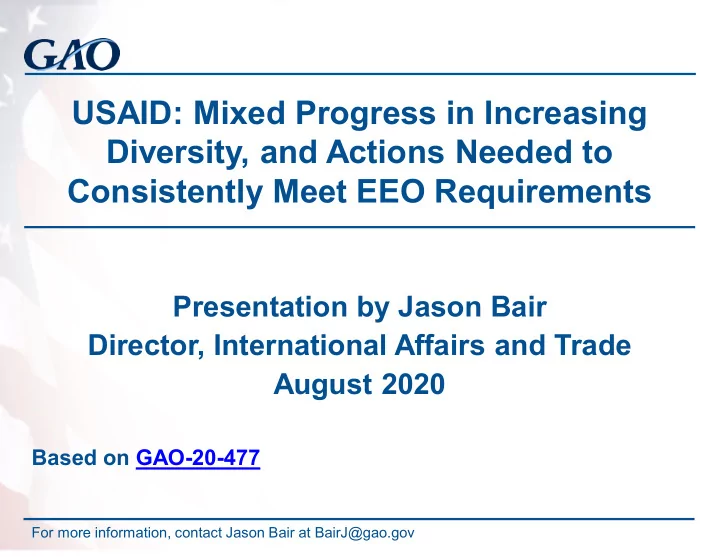

USAID: Mixed Progress in Increasing Diversity, and Actions Needed to Consistently Meet EEO Requirements Presentation by Jason Bair Director, International Affairs and Trade August 2020 Based on GAO-20-477 For more information, contact Jason Bair at BairJ@gao.gov
Background • Concerns about the demographic composition of the U.S. Agency for International Development (USAID) workforce are longstanding. • USAID has a stated commitment to fostering an inclusive workforce that reflects that diversity of the United States. • In fiscal year (FY) 2018, USAID’s workforce included 2,964 full- time, permanent, career employees, including • 1,666 Foreign Service • 1,298 Civil Service Page 1
Research Objectives Our report examined (1) the demographic composition of USAID’s workforce in FYs 2002 through 2018, (2) any differences in promotion outcomes for racial or ethnic minorities in USAID’s workforce, (3) any differences in promotion outcomes for men and women in USAID’s workforce, and (4) the extent to which USAID has identified workforce diversity issues and worked to address them. Page 2
Methodology • Analyzed demographic characteristics of more than 5,750 USAID personnel employed during FYs 2002-2018. • Conducted descriptive analyses of USAID promotion data. • Conducted adjusted statistical analyses of promotion data, accounting for factors other than racial or ethnic minority status and gender that could influence promotion. • Our analyses do not completely explain the reasons for differences in promotion outcomes, which may result from various unobservable factors. Thus, our analyses do not establish a causal relationship between demographic characteristics and promotion outcomes. • Reviewed USAID workforce diversity reports and interviewed USAID officials and employee group representatives. Page 3
Overall Proportion of Racial or Ethnic Minorities Grew, although Proportion of African Americans Declined Page 4
Proportions of Racial or Ethnic Minorities Were Smaller in Higher Ranks in FY 2018 Page 5
Proportion of Women Increased Overall, Rising in Foreign Service While Declining in Civil Service Page 6
Proportion of Women Was Generally Smaller in Higher Ranks in FY 2018 Page 7
Promotion Outcomes Were Generally Lower for Racial or Ethnic Minorities and Mixed for Women • We conducted descriptive analyses of average promotion rates. • We also conducted adjusted analyses, accounting for various individual factors that could influence promotion—for example, occupation, education, language skills, hardship assignments, and years of federal service. However, our analyses do not account for various other factors, such as employee skills, that may have caused differences in promotion outcomes. • We analyzed the Civil and Foreign Services separately because of differences in the two services’ structures and promotion processes. Page 8
Civil Service Promotion Outcomes Were Lower for Racial or Ethnic Minorities Than for Whites in Early to Mid Career in FYs 2002-2017 Note: Our adjusted analysis does not completely explain the reasons for differences in odds of promotion, and our regression results do not Page 9 establish a causal relationship between demographic characteristics and promotion outcomes.
Foreign Service Promotion Outcomes Were Lower for Racial or Ethnic Minorities in Early to Mid Career in FYs 2002-2017, but Differences Were Generally Not Statistically Significant Note: Our adjusted analysis does not completely explain the reasons for differences in odds of promotion, and our regression results do not Page 10 establish a causal relationship between demographic characteristics and promotion outcomes.
Civil Service Average Promotion Rates Varied for Women Compared with Men in FYs 2002-2017, but Differences in Outcomes Were Not Statistically Significant Note: Our adjusted analysis does not completely explain the reasons for differences in odds of promotion, and our regression results do not Page 11 establish a causal relationship between demographic characteristics and promotion outcomes.
Foreign Service Average Promotion Rates Were Generally Higher for Women Than Men in FYs 2002-2017, but Differences in Outcomes Were Generally Not Statistically Significant Note: Our adjusted analysis does not completely explain the reasons for differences in odds of promotion, and our regression results do not Page 12 establish a causal relationship between demographic characteristics and promotion outcomes.
Staffing Gaps Have Prevented USAID from Responding Timely to Equal Employment Opportunity (EEO) Complaints, Analyzing Its Workforce, and Reporting on Diversity Efforts Page 13
GAO Conclusions • Although USAID has identified some diversity issues, continued underrepresentation and generally lower promotion outcomes suggest additional efforts are needed. Addressing these efforts requires an effective and efficient EEO program. • USAID's Office of Civil Rights and Diversity (OCRD) has been unable to perform its key functions because of significant staffing gaps and turnover. Further, sustained attention from USAID’s senior leadership would be helpful in providing sufficient staffing resources to ensure OCRD has the capacity to perform its required functions. Page 14
GAO Recommendations 1. Ensure that OCRD consistently responds to equal employment opportunity complaints in a timely manner. 2. Ensure that OCRD consistently analyzes USAID workforce demographic data for trends and potential barriers to equal employment opportunity. 3. Ensure that OCRD submits required MD-715 reports to the Equal Employment Opportunity Commission in a timely manner. 4. Demonstrate senior leadership attention to diversity by ensuring that OCRD has the capacity to perform required equal employment opportunity functions. USAID concurred with all four recommendations. Page 15
Additional Workforce Analyses Included in Appendices to the GAO Report Descriptive Analysis Adjusted Analysis • Executives • Attrition rates • Veterans • Average years in rank • Political appointees • Applicants to USAID • Newly hired USAID employees Page 16
Recommend
More recommend